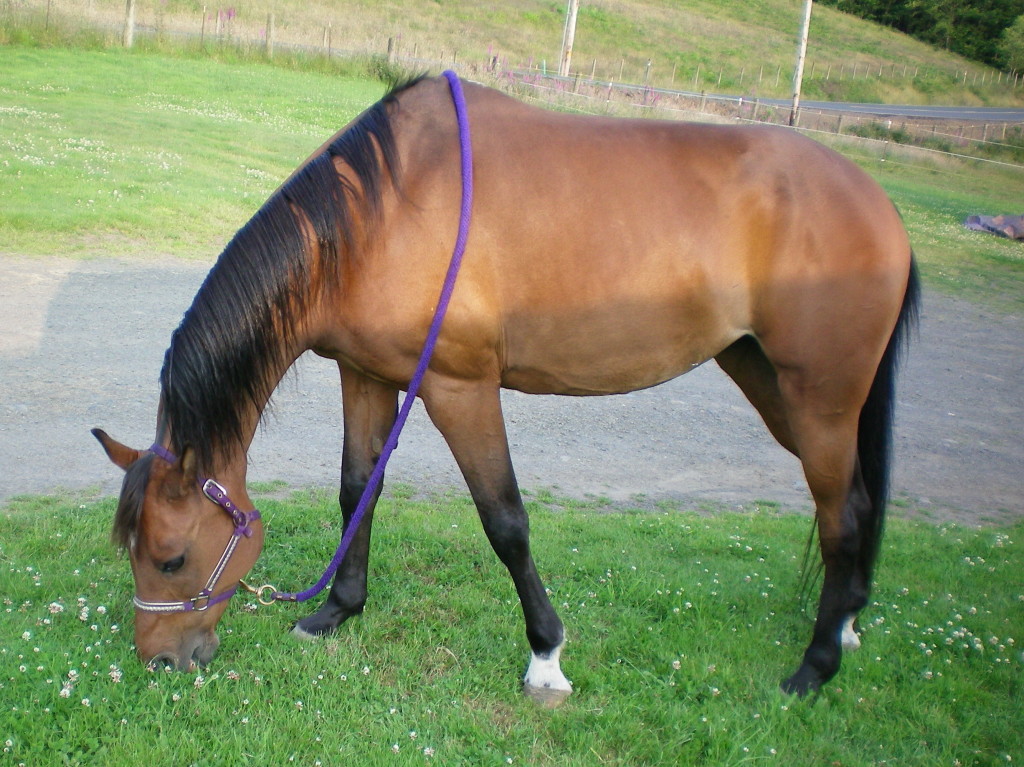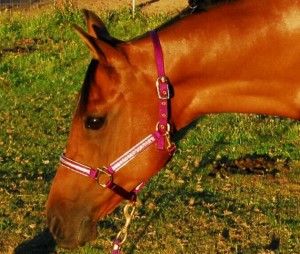No one wants a horse that bucks. With a horse that is very good at bucking, it’s not a question of whether you will come off the horse, it’s a question of how long it will take.
If you ride or work with “other” horses, chances are that you will come across a horse that bucks.
Every healthy horse bucks. Yet horses do not enjoy prolonged bucking, and only do it when they feel it is necessary. If you watch healthy horses at play, you will see them throw in a buck after rolling, after a good race around a field, or when hitting a patch of soil that feels different under their feet. They will often buck after jumping playfully over a ditch or log as well. What you don’t see are happy horses in their home environment bucking multiple times in a row just for fun. They may buck once or twice, then they move on. More than that is quite tiring and is due to either discomfort or sometimes from venting their frustration after being kept in a small space for too long.
From this we can deduce that any horse we come across that bucks multiple times in a row has some resolvable issue that we need to discover and take care of. Bucking (except for the occasional joyful buck) is not the problem, it is a symptom of the problem.
There is no such thing as a “cold backed” horse. The term is used for horses that buck either when they are first cinched up or when the rider sits in the saddle. If a horse only bucks when the saddle is on, either the saddle doesn’t fit, the horse finds the saddle uncomfortable and/or frightening, or the horse has a sore back. Owners often laugh and say their horse is great, calm, well-meaning but cold backed. If they really thought about it logically, they would realize that a great, calm, well-meaning horse is only going to buck if the saddle pinches them or their back is hurting.
Sometimes the horse will buck while being lunged under saddle before the rider gets on, and then will not buck while being ridden. This is sometimes because the area of the back gets numb where it is being pinched, the horse accepts the pain, or they get used to the feeling of the back cinch (often you will see a supposedly cold backed horse is being ridden with a back cinch and the real issue is that they dislike the strap so far back near the area where bucking straps are put on rodeo horses).
If a horse begins bucking the second you sit in the saddle, you should get off immediately and assume the horse has a back problem or the saddle is a very poor fit for the horse. I have seen a few horses that bucked or reared when the rider sat down; without any intervention other than a new saddle, these horses never displayed the behavior again. If you are going to ride horses in a saddle, you need to learn how to assess for saddle fit. Saddles that do not fit will cause the horse pain, whether the horse shows it visibly or not. There is no excuse for hollow areas behind the shoulders, white hairs or atrophied back muscles. Any horse being ridden in a well fitting saddle will have round, strong back muscles on either side of their spine (unless they have other severe hoof, back or leg problems, in which case they often shouldn’t be ridden anyway).
I recommend the following resources to learn about saddle fit:
The truth is that many horses are ridden regularly in saddles that fit poorly and cause the horse pain. Sometimes I think of the “other” horses as the honest horses. They are the ones that won’t simply suffer in silence. They are too sensitive, high-spirited and prone to hysterical responses and therefore you will know when something is wrong. In a way, this a real plus since you will not unintentionally harm these horses; they also can help you understand what things we should not ask horses to do, whether the horses protest loudly enough for us to notice or not.
Another common reason for horses to buck is that the rider or handler does not give the horse any other option. Horses always need an escape route. It is part of their nature as a prey animal that they will only feel safe if they feel they have the option to kick up their heels and gallop to safety if necessary. You cannot drive a horse forward, block his forward motion and backward motion, and expect that he won’t buck or rear. There are many mellow horses that will accept this type of treatment without panicking. But a “square” horse must always have the illusion that he can flee even if you don’t actually wish for him to take that route. Otherwise you will run into real trouble.
In this same vein, even if your horse is moving faster than you are comfortable with, you must sometimes ride a very fine line between asking the horse to slow and making sure the horse does not feel trapped. This give and take may require some experience before you get it right, but it is a critical skill you must learn. If you try to hold back a horse that feels he must move his feet, it will have the opposite effect of what you are trying to achieve; safety. It won’t be long before he panics completely and then you will have lost the ability to communicate with him altogether. This is when horses “explode,” and rear, buck, bolt, flip over, fall down, etc.
The good news is that often just the smallest release will convince a horse that he can move forward if he needs to, and can prevent all out panic. But it is also very important to gain a feel for when a horse is becoming more calm, more excited, or has reached a plateau. In situations where you cannot let the horse run for everyone’s safety, the horse must either plateau or become more calm. If he keeps getting more excited, then you will reach that explosion point before too long unless you let out more energy than what is building up inside of him. Sometimes the best solution is to get off the horse and let him circle around you. Removing your own thoughts of falling off the horse can often be enough to keep the situation safe.
Times when you should completely ignore bucking:
1) The horse is cantering for the first time or two under saddle. It is common for horses to crow-hop or buck on their first couple of canters and this will resolve once they get used to the feeling of the saddle and rider at this faster pace. To reduce the likelihood of this happening you can:
- Canter the horse with a saddle on the lunge line before riding at the canter
- Take the horse out for the first time with a calm, older, role model horse
- Wait until you are halfway up a steep, long hill so the horse has to focus his energy. Most horses being started do not have good physical stamina or coordination so will not have the strength to continue bucking up a hill.
- Canter on firm ground since many horses naturally feel an urge to buck when running on soft, yielding ground.
- If the horse bunches over keep him moving forward and don’t let him lower his head. Horses must put their heads down in order to do the really big, rodeo style bucks.
2) If your horse throws in a joyful buck, no matter how big, tell him to knock if off but don’t panic or begin remedial training. There are times when you have to either just forget about a buck or try to avoid the same circumstances in the future. Even if you get thrown off, it is not a true behavior problem if you gallop your horse down a hill, jump him over a log and he lands in soft, delightful dirt and kicks up his heels. I’ve seen well-trained horses that have never bucked before or after this scenario give in to the temptation.
3) If your horse is faced with an unusual dilemma or sudden pain. For instance, if your horse gets stung by a wasp, touches an electric fence or his saddle slides back to his flank area going up a steep hill. Bucking in these cases are not related to behavioral problems but are natural responses in the horse world. Horses that buck in these circumstances are not going to develop a bucking habit and you have no real reason to fear getting bucked off in the future unless you like to ride in a minefield of wasp nests.
Hopefully, knowing that your horse does not really wish to buck can help you see this is a solvable problem. My mare, Amore used to buck with such athleticism that it was impossible to stay on for more than three or four bucks. She would panic severely at unexpected sights, sounds or sensations and immediately begin bucking based on the instinct to get everything off her body so she would be free to run to safety. Initially she would panic every 4-5 rides, then every 10, then every 20. Eventually she understood that there was never any need to panic that badly at all, and all she needed was enough time under saddle and to learn to trust a rider. She has not bucked under saddle for a few years now. When we were starting out, I learned that she would forget there was a rider with her, and speaking to her often would prevent some of her panic. Any type of punishment for bucking would only have made the issue worse, since she could have easily associated the punishment with the cause of the bucking rather than the bucking itself, and then feared the garbage can/donkey/leaf more than she did before.
A final word of advice:
Kevin Richardson, the so-called “Lion Whisperer” does not go into the enclosure with the big cats on his reserve unless their body language shows they are in an accepting mood. Likewise, don’t be stupid. If your high-energy, reactive horse is more worked up or agitated then normal, wait to ride or work with her on another day. Otherwise you are asking for trouble. One day I was stupid and decided to trim a high-strung mare’s hooves during a thunderstorm. This mare and I have a good understanding with each other, but on this day she kicked me. I reprimanded her, obviously but this was completely my fault. Don’t get injured because of some arbitrary goal or your own stubborn nature.
With a short back and flexible frame, Amore is a talented bucker.
Amore’s motto used to be: ipanic


